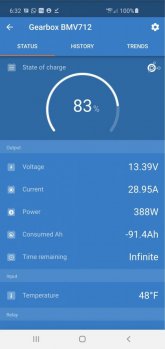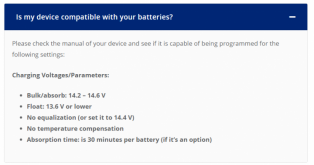There have been concerns posted on the forum about the charge profile used by the IOTA Engineering IQ4 LiFePO4 module. This is a plug-in module used in their DLS series converters that come in different amp ratings as well as different volt ratings. I sent questions to their Tech Support group last week and received a response today. Their responses are in indented quote formatting after my question. Some of the questions highlight my lack of familiarity with their charge profile and charging in general. Their responses have been pasted into this post verbatim.
Link to the main product page for the module: IQ4 Module
Link to the IQ4 LiFePO4 manual (PDF)
1. Why can’t I get to this document (the manual in the second link above) from within your website? Shouldn’t it be available from this web page? I used the search feature on your website and could not find this document.
2. Why is the bulk charge spec’d out to be 14.7v? Most LiFePO4 batteries want no more than 14.6 volts. In fact, my BMS will throw an exception if charging exceeds 14.6v.
2b. If the trigger is 14.6v, how can it charge at 14.7v?
3. The paragraph below (in italics) from the manual is confusing. The criticism on the forum primarily focuses on the 120-minute timeout, saying that if a battery needs more charging in bulk mode than the timeout allows, then the battery may not get charged to 100%.
3a. Can you provide guidance on when constant current operation and constant voltage operation are used?
3b. What are the criteria for determining that a battery is discharged, forcing the charger into constant current?
3c. If the module knows that the 14.6v trigger has been reached, why would it stay in bulk mode for another 15 minutes? Wouldn’t this overcharge the battery?
BULK STAGE - During this state, the charger will operate either at Full Current output or Constant Voltage output depending on the discharged state of the battery. A discharged battery will dictate the voltage and force the charger into constant-current operation. As the battery charges, the charger transitions to a constant-voltage operation. This BULK STAGE will continue for either 120 minutes or until the battery voltage reaches the “High Trigger” value (whichever occurs first). At this point, the BULK STAGE will operate for another 15 minutes before switching to the FLOAT STAGE.
Link to the main product page for the module: IQ4 Module
Link to the IQ4 LiFePO4 manual (PDF)
1. Why can’t I get to this document (the manual in the second link above) from within your website? Shouldn’t it be available from this web page? I used the search feature on your website and could not find this document.
The spec. sheet is not currently availble on our website. There have been many changes to our website since we were acuired by Acuity, I will bring it up.
2. Why is the bulk charge spec’d out to be 14.7v? Most LiFePO4 batteries want no more than 14.6 volts. In fact, my BMS will throw an exception if charging exceeds 14.6v.
2a. I have used my converter for a few hours, and I have yet to see in the log of my BMS that the charge voltage has been cut off due to exceeding 14.6v. Is it the case here that the charger is operating at constant current, not constant voltage? I have yet to see my LiFePO4 battery bank go below 70%, so I would assume that my charger has not gone into constant current operation.The IQ modules will not fit every battery out there. I beleive the IQ-LifePo was designed around Battleborn batteries.
The unit will output 14.7V, but since the battery is at a lower voltage you will read a voltage in between. As the battery charges, the voltage you read will increase.
2b. If the trigger is 14.6v, how can it charge at 14.7v?
If the voltage reaches 14.6VDC before the 4 hour mark, the unit will trigger out.
3. The paragraph below (in italics) from the manual is confusing. The criticism on the forum primarily focuses on the 120-minute timeout, saying that if a battery needs more charging in bulk mode than the timeout allows, then the battery may not get charged to 100%.
3a. Can you provide guidance on when constant current operation and constant voltage operation are used?
3b. What are the criteria for determining that a battery is discharged, forcing the charger into constant current?
3c. If the module knows that the 14.6v trigger has been reached, why would it stay in bulk mode for another 15 minutes? Wouldn’t this overcharge the battery?
1. For simplicity, the following explanation will ignore resistances of the cells and cables. A discharged LiFePO4 cell is 3.3V; a 4 cell discharged battery will be 13.2V. When a the charger is energized, it will operate in constant current (CC) mode because the terminal voltage is 1.4 volts below its voltage regulation point (14.6V). As the cell voltages increase the charger will continue to provide the constant charge current until the battery voltage reaches the regulation point of the charger (14.6V or 3.65V/cell). In this example (0Ω), once the charger reaches its constant voltage mode the battery will be fully charged (~95%). Realistically, when resistances are added to the system, the constant voltage mode will provide tapering of the charge current until the cell voltage eventually reaches its end voltage of 3.65V/cell. Briefly stated:
a. During constant current mode the charger controls the charge current and the battery controls the bus voltage
b. During constant voltage mode the charger controls the bus voltage and the battery controls the charge current
2. On initial startup, while limiting its output current to a specific value, the charger attempts to raise its output voltage to 14.6V. If the attached load (cell voltages and the IR losses from cell & cable resistances) results in a voltage at charger terminals of less than 14.6V, then the charger is in constant current mode. It remains in constant current mode until the cell voltages increase to a point that the voltage at the charger terminals is equal to 14.6V, this is the transition point from constant current (CC) to constant voltage (CV) operation.
3. Unlike the 0Ω example above, there are resistances in the cells and in the distribution cables. Ideally, during these 15 minutes, the current tapers down to a minimal value to achieve a finished cell voltage of 2.65V. In addition, during these 15 minutes the Battery Maintenance System (BMS) can balance unequal cells as required.
BULK STAGE - During this state, the charger will operate either at Full Current output or Constant Voltage output depending on the discharged state of the battery. A discharged battery will dictate the voltage and force the charger into constant-current operation. As the battery charges, the charger transitions to a constant-voltage operation. This BULK STAGE will continue for either 120 minutes or until the battery voltage reaches the “High Trigger” value (whichever occurs first). At this point, the BULK STAGE will operate for another 15 minutes before switching to the FLOAT STAGE.




